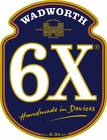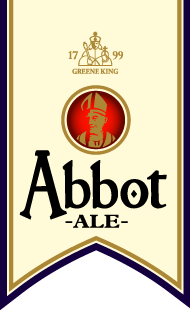Recipe: Swampswill 6X (version 1.0)
The recipe and process can be found online here. My wife came up with name Swampswill as a play on Marshfield, with our house backing a large marsh swamp, can’t think were she came up with swill, more like nectar in my opinion.
 This is my first attempt at replicating another British Real Ale Classic, Wadworth 6X, brewed at the Northgate Brewery in Devizes, Wiltshire. This is probably one of the independent classic ales of the South of England with its predominantly malty fruit, full bodied flavour. It is hard to classify, its sold as a Best Bitter but the hop IBU level is low, below the recommended BJCP minimum for an ale of this class. I really don’t care, its a fine session brew and something I hope to replicate, if I can, as this beer is VERY hard to come by in the US.
This is my first attempt at replicating another British Real Ale Classic, Wadworth 6X, brewed at the Northgate Brewery in Devizes, Wiltshire. This is probably one of the independent classic ales of the South of England with its predominantly malty fruit, full bodied flavour. It is hard to classify, its sold as a Best Bitter but the hop IBU level is low, below the recommended BJCP minimum for an ale of this class. I really don’t care, its a fine session brew and something I hope to replicate, if I can, as this beer is VERY hard to come by in the US.
A brilliant example of traditional ale at its best – biscuity, fruity, gently hoppy and wonderfully refreshing. – The Real Ale Almanac
, Roger Protz
The Wadworth Brewery Ltd was founded in 1875 by Henry Wadworth, an already accomplished brewer at 22. He went on to design the impressive Northgate Brewery in 1885 when he, and business partner and friend John Bartholomew, ran out of space. It is is run today as it was then, as a family business. When built the brewery at Northgate was state of the art with Henry Wadworth building the brewing equipment into the fabric of the building, much of which is still used today. Back in 1885 power was hard to come by so much of the brewing process incorporated old fashioned gravity to move the wort from mash tun to fermenter to fermenter with cylinders being built inside a grand tower atop the brewery, a similar technique employed by many all-grain homebrewers today. Northgate is one of the only remaining breweries to employ a full time cooper to build oak casks to ship the ale, (note to self, oak chips to be used in this recipe).
The first 6X was first brewed on June 16th 1921 and has been brewed ever since. The name XX’s comes from medieval monastic times when literacy levels were poor so monks would mark X’s on oak casks to define the strength of a brew, the more XX’s the stronger the brew. Between the 2 world wars Wadworth also brewed an XX Mild, XXXX and XXXX pale ale. It is rumored a young employee at the brewery whose job it was to stencil the XX’s on the casks decided to write 6X instead of the XXXXXX and the name has stuck ever since.
On to the ingredients, as with our last couple of recipes the company website and almanac are very forthcoming with the basic ingredients and parameters for the brew. The website is kind enough to provide the malt as % with 93% pale malt, 4% crystal, and 3% cane sugar, 85% fuggles and 15% Goldings for the hops. The SRM is approx 16 and an ABV of 4.3%. This is probably the most forthcoming brewery I have found yet, these % help a lot but our final breakdown will change as we convert the pale malt into DME.
The almanac provides some additional details, specifically the low IBU level of 23 and confirms the ingredients listed on the website. It lists the OG as 1040, FG 1008 and an ABV of 4.3%.
Next stop is to input the ingredients into the beer calculus system on hopville.com and balance the quantities in order to create a workable recipe conforming to the constraints above and ingredients available to homebrewers.
Base Malt: Given this is an extract recipe we need to replace the Pale Malt with Light DME. Had no problems balancing the the OG and colour between the base malt and specialty grains so we do not require an additional darker base malt.
Specialty Grains: Both the Almanac and the web site state the use of Crystal as the specialty grain. After fiddling around on the calculator it became clear we need to use Crystal 120L to get both the malty caramel flavour and the rich colour. After our apparently successful experience with the Fullers ESB clone (though it is still too early to really tell) it looks like we will also need a little Black Malt to kick the SRM to 16 without having to add too much to the OG and providing some additional rich malty flavour the tasting notes call for.
Hops: As stated in the almanac and the website, we shall be using Fuggles and Goldings. Given the alpha content of the Fuggles hops I have in inventory are higher than average we can use less to gain the stated IBU. The calculator calls for 2/3 Fuggles and 1/3 Goldings.
Yeast: The yeast profile for this brew definitely calls for fruit. The high ABV relative to the lower OG calls for a yeast with high attenuation. The choice for version 1.0 is Wyeast London Ale.
Swampswill 6X (BJCP Beer Style: Special/Best/Premium Bitter, category: English Pale Ale)
- 2.5 Gallon, 60 min boil
- OG 1043, FG 1011
- 4.3% ABV
- 23 IBU
- 16° SRM (Copper to Deep Copper)
- Ready to drink in 6-7 weeks
Base Malt and Fermentables:
- 2 lbs Light Dry Malt Extract (60 mins)
- 3oz Cane Sugar (at the end of the boil)
Specialty Grains:
- 5 oz Crystal Malt – 120L
- 1 oz Black Malt
Hops
- Bittering Hop – 0.5 oz Fuggle (60 mins)
- Aroma Hop – 0.25 oz Kent Goldings (15 mins)
Yeast
- Wyeast London Ale (#1028) (Attenuation 73-77%, Flocculation: Medium Low)
Other Additions
- 1 tsp Irish Moss (30 mins)
- Packet of Isinglass Liquid (to help remove any lingering proteins given the low flocculation level of the yeast)
- 1oz Oak Chips in the secondary
Process
- Please follow the process guidelines outlined in my post here. You will require all the equipment specified here.
- Primary Fermentation: 5-7 days at 65-75°
- Secondary Fermentation: 2 weeks at 55° (if you can otherwise just 5-7 days in the same location as the primary), add oak chips to the fermenter after soaking the chips for at least 24 hours and sterilizing them.
- Prime and store in the bottle for at least 2 weeks before consuming
- Peak flavour will be reached after 4 weeks in the bottle


